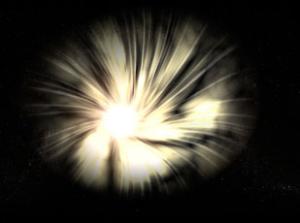
© SPL
Swarms of tiny black holes forged in the big bang may have killed off the universe's first stars by devouring them from within. The digested end-products could then have grown into the colossal black holesMovie Camera now lurking in the centres of galaxies, whose origins have long been a mystery.
Some physicists speculate that minuscule black holes may have been forged in the very dense soup of matter and radiation that prevailed in the first moments of the universe's existence. If so, these might account for at least some of the invisible dark matter that pervades the universe.
Now Cosimo Bambi of the University of Tokyo in Japan and colleagues have shown that these black holes could also have destroyed the universe's first stars by eating them from the inside out.
The first stars are thought to have formed around 200 million years after the big bang, in the centres of the universe's densest dark matter clumps. Stars would have been most likely to ignite there because the dark matter's gravity would have pulled in the gas necessary for them to form.